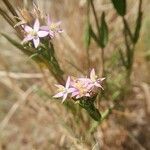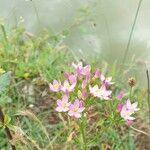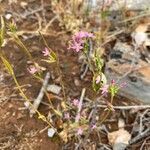Glabrous, erect annual with stems usually to 25-(40) cm tall, sometimes much-branched. Lvs mostly cauline, not forming well-defined and persistent rosettes, 5-30 × 2-12 mm, oblong-elliptic, ovate to narrow-lanceolate, 3-veined; apex obtuse or acute. Infl. a fairly dense dichasial cyme. Fls subsessile or shortly pedicellate. Main bracts linear or oblong-lanceolate, 5-15 mm long. Calyx 5-7 mm long; lobes narrow-linear, < corolla tube. Corolla 7-12 mm long; tube narrow-cylindric, white, rose towards apex; lobes c. 3 × 1-2 mm, oblong or narrow-lanceolate, patent, rose, acute. Capsule 7-10 mm long, fusiform. Seed alveolate, minute.



